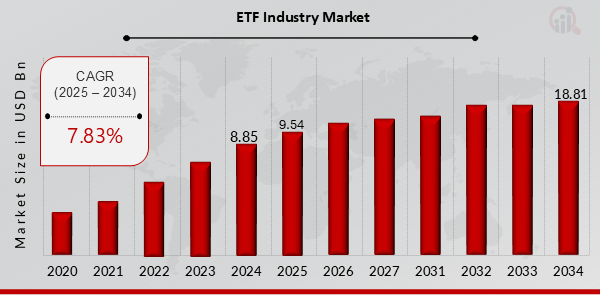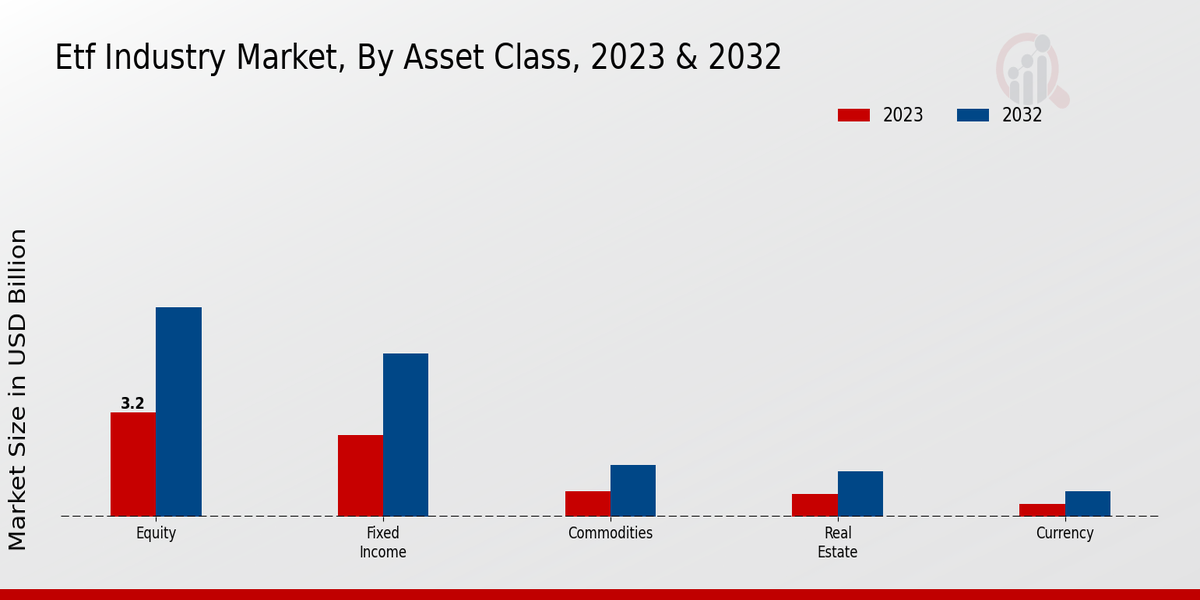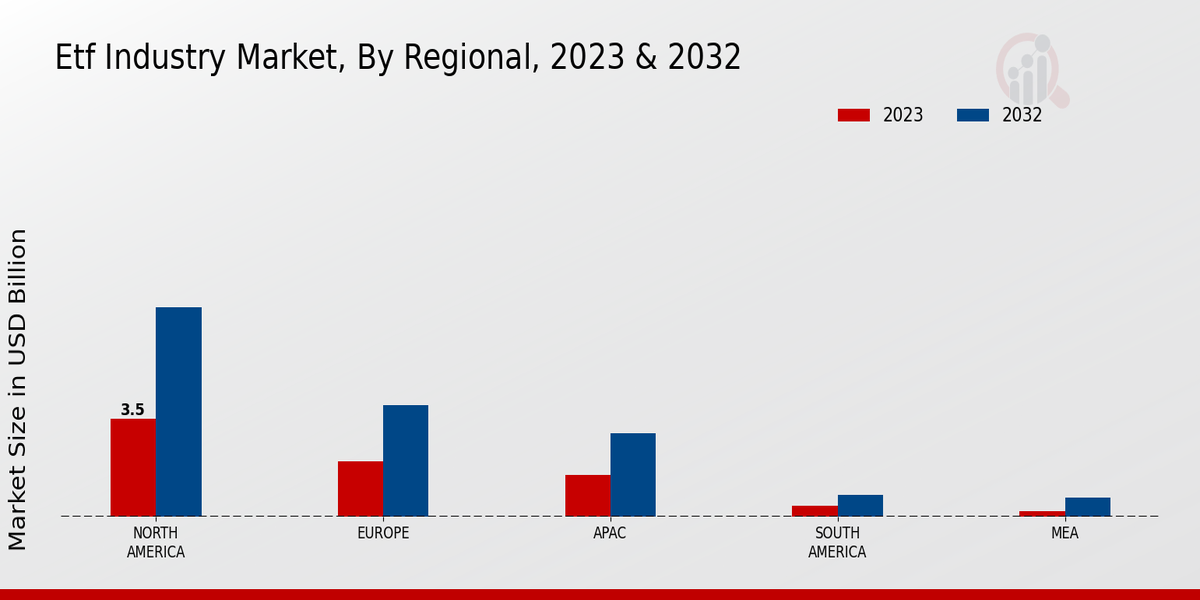Global ETF Industry Market Overview:
ETF Industry Market Size was estimated at 8.85 (USD Billion) in 2024. The ETF Industry Market Industry is expected to grow from 9.54 (USD Billion) in 2025 to 18.81 (USD Billion) till 2034, exhibiting a compound annual growth rate (CAGR) of 7.83% during the forecast period (2025 - 2034).
Key ETF Industry Market Trends Highlighted
The Global ETF Industry is experiencing significant growth driven by several key market drivers. Increasing investor demand for low-cost investment options has led to a surge in the popularity of exchange-traded funds. Investors appreciate the flexibility and transparency that ETFs offer, making them an attractive alternative to traditional mutual funds. The rising awareness of passive investment strategies further enhances the appeal of ETFs, as they typically provide diversified exposure to various asset classes without high management fees. Furthermore, advancements in technology and trading platforms have made it easier for both retail and institutional investors to access and trade ETFs.There are numerous opportunities within the ETF market thaNumerous opportunities within the ETF market can be explored or captured. Innovative product offerings, such as thematic and actively managed ETFs, present new avenues for growth. Companies can leverage these trends to meet the evolving preferences of investors looking for targeted strategies that align with personal values, such as sustainability or specific market themes. Additionally, expanding into emerging markets can offer access to a new pool of investors who are increasingly seeking efficient ways to invest in local and global markets. Education about ETFs is also essential in opening up opportunities, as many potential investors still lack a comprehensive understanding of how ETFs work. Recent trends indicate a strong shift towards environmental, social, and governance (ESG) focused ETFs, reflecting a growing investor preference for sustainable investment options. The increased interest in technology-driven investment solutions and automated trading is also shaping the market landscape. As financial advisors and brokerages adopt technology into their service offerings, they may find new ways to incorporate ETFs into client portfolios. This integration underscores the ongoing evolution of the ETF industry, signaling a future of increased customization and diversification tailored to investor needs. Overall, the Global ETF Industry is positioned for continued growth and innovation as it adapts to the changing preferences of investors.

Source: Primary Research, Secondary Research, MRFR Database and Analyst Review
ETF Industry Market Drivers
Rise in Popularity of Passive Investment Strategies
The increasing popularity of passive investment strategies is a significant driver for the ETF Industry Market Industry. In recent years, investors have gravitated towards low-cost, passive investment options, seeking to optimize returns without the burden of high management fees. This trend is backed by a growing body of research suggesting that, over the long term, passive strategies often outperform actively managed funds. ETFs, or Exchange-Traded Funds, offer a perfect vehicle for passive investing, as they typically mirror the performance of a specific index or sector instead of attempting to pick individual stocks. Investors appreciate this transparency, as they can quickly assess the underlying assets of their ETF holdings. The ease of trading ETFs on stock exchanges further enhances their attractiveness, providing investors with flexibility similar to individual stocks. Furthermore, the technological advancement in trading platforms has enabled both institutional and retail investors to access these financial instruments conveniently. As the trend toward passive investing continues to solidify, the ETF Industry Market is positioned for substantial growth, reflecting a shift in investor mentality toward long-term wealth accumulation and cost-efficient strategies.
Technological Advancements in Trading Platforms
Technological advancements in trading platforms have significantly transformed the ETF Industry Market Industry landscape. With the rapid development of online trading technologies and mobile applications, investors now enjoy unprecedented access to financial markets. This technology permits real-time trading, analysis, and seamless execution of trades for ETFs. Additionally, these innovations enable individual investors to undertake informed investment decisions, enhancing their overall trading experience. Online brokerage firms have increasingly integrated advanced trading features and analytics capabilities, thus empowering investors to build diversified portfolios that align with their financial goals.
Growing Demand for Diversification
In the current investment climate, there is a marked increase in the demand for diversification, which acts as a crucial driver for the ETF Industry Market Industry. Investors are increasingly aware of the risks associated with concentrated portfolios and are seeking methods to hedge against market volatility. ETFs provide an effective means of achieving diversification over various asset classes, including stocks, bonds, and commodities, while also maintaining liquidity. This characteristic is particularly appealing to investors, as it allows them to balance risk and return efficiently. Moreover, as markets fluctuate, the appeal of creating a more resilient investment portfolio through the utilization of ETFs becomes ever more pronounced.
ETF Industry Market Segment Insights:
ETF Industry Market Asset Class Insights
The Asset Class segment within the ETF Industry Market represents a dynamic landscape that contributed significantly to the overall market valuation of 7.61 USD Billion in 2023. This segment is primarily driven by strong market growth and diversification trends, allowing investors to access various investment avenues with ease.
Among the various asset classes, equity stoodands out with a valuation of 3.2 USD Billion in 2023, expected to double to 6.4 USD Billion by 2032, thereby demonstrating its major influence and majority holding in the market. The dominance of equity ETFs is attributed to their capability to provide exposure to a broad array of stocks, offering investors the potential for substantial returns in a growing economy.
Fixed income, valued at 2.5 USD Billion in 2023 and anticipated to reach 5.0 USD Billion in 2032, remains another pivotal segment that caters to those seeking safety and stability in their investment portfolios. The steady income generation and lower risk associated with fixed fixed-income investments appeal to conservative investors, helping to bolster this segment significantly over the forecasted period.
Meanwhile, the commodities sector, with a valuation of 0.8 USD Billion in 2023 and growing to 1.6 USD Billion in 2032, is gaining traction amidst increased inflation concerns and commodity price volatility, providing investors with a hedge against economic downturns.
Real estate wais valued at 0.7 USD Billion in 2023, expected to amplify to 1.4 USD Billion by 2032, underscoring the ongoing interest in real estate investment trusts (REITs) and direct real estate exposure. This segment offers diversified returns through income-producing properties, appealing to a wider audience of investors.
Finally, the currency market segment, valued at 0.41 USD Billion in 2023 with a projected growth to 0.8 USD Billion in 2032, addresses the demand for currency trading and exchange rate exposure. Despite its comparatively smaller size, currency ETFs cater to a niche yet significant market, driven by foreign exchange trading strategies. Overall, the ETF Industry Market segmentation by asset class showcases a robust framework catering to diverse investor preferences and optimizing portfolio strategies, as reflected in the evolving market statistics and data.

Source: Primary Research, Secondary Research, MRFR Database and Analyst Review
ETF Industry Market Investment Strategy Insights
The ETF Industry Market is projected to reached a value of 7.61 billion USD in 2023, reflecting a growing interest in investment strategies that cater to diverse investor needs. Within this market, the segment of Investment Strategy is critical as it encompasses various approaches, such as Passive, Active, Strategic, and Tactical strategies.
Passive investment strategies have gained popularity due to their cost-effectiveness and simplicity, appealing to investors seeking long-term growth without frequent trading. Active strategies, on the other hand, are favored by those looking for potential outperforming returns, involving more frequent management and adjustments. Strategic investment approaches focus on long-term asset allocation based on market conditions, proving essential in navigating volatility. Tactical strategies provide flexibility by allowing the reallocation between asset classes based on short-term market trends, capturing swift opportunities.
This diversity in strategies not only enhances the overall ETF Industry Market revenue but also highlights the dynamic nature of investor preferences and risk tolerance, fueling significant market growth. Key market trends include increasing investor awareness, along with technological advancements that drive operational efficiency. However, challenges such as market volatility and regulatory changes could influence strategic decisions within the industry, leading to a complex yet promising landscape for investors and fund managers alike.
ETF Industry Market Distribution Channel Insights
The Distribution Channel segment of the ETF Industry Market plays a crucial role in shaping the overall market dynamics, which wais valued at 7.61 billion USD in 2023. This segment includes various channels such as Direct sales, Brokerage services, Financial Advisers, and Online Platforms.
Each channel contributes significantly to market penetration and investor access. The Direct channel is essential for institutional investors seeking streamlined transactions, while Brokerage services serve a diverse range of retail and institutional clients, offering a reliable avenue for ETF investments. Financial Advisers are increasingly pivotal as they guide clients in navigating the vast array of ETFs, enhancing market growth by fostering trust and informed decision-making. Online Platforms have revolutionized access by providing user-friendly interfaces, which attract tech-savvy investors. As internet adoption grows, this channel experiences significant increases in usage. The segmentation of the ETF Industry Market reflects diverse strategies and investor preferences, revealing a landscape where the right distribution channel can greatly impact investment performance and accessibility. The variety within this sector also presents opportunities for innovation and adaptation to changing market needs.
ETF Industry Market Fund Size Insights
The ETF Industry Market, valued at 7.61 USD Billion in 2023, reflects a robust growth trajectory, particularly within the Fund Size segment, which encompasses various categories such as Small Cap, Mid Cap, Large Cap, and Mega Cap. Each of these categories plays a vital role in shaping market dynamics and investor interests.
Small Cap ETFs cater to investors seeking growth potential in emerging companies, whereas Mid Cap ETFs provide a balance of growth and stability, typically outperforming during economic recoveries. Large Cap ETFs dominate the market due to their established companies, which offer reliability and strong fundamentals. Mega Cap ETFs, representing the largest companies, serve as a safer choice during market volatility, making them significant for risk-averse investors. Overall, the Fund Size segment is pivotal as it accommodates diverse investment strategies, boosts market liquidity, and aligns with varying investor objectives, ultimately driving growth in the ETF Industry Market statistics. The segmentation of the ETF Industry Market data highlights the diverse opportunities within each Fund Size category, aligning with current market trends and investor preferences.
ETF Industry Market Regional Insights
The ETF Industry Market is exhibiting robust growth across various regions, with North America leading the charge. In 2023, North America holds held a significant market value of 3.5 USD Billion and is projected to rise to 7.5 USD Billion by 2032, dominating the overall landscape due to its advanced trading infrastructure and high investor engagement.
Europe follows followed with a valuation of 2.0 USD Billion in 2023, expected to reach 4.0 USD Billion in the coming years, driven by increasing adoption of ETFs among institutional investors. The APAC region, valued at 1.5 USD Billion in 2023, is also anticipated to see growth, reflecting a rising trend in automated trading solutions, particularly in countries like Japan and China. South America and MEA represent emerging opportunities with valuations of 0.4 USD Billion and 0.21 USD Billion in 2023, respectively. South America is gradually gaining traction due to increasing interest in diversified investment products, while the MEA region showcases growth potential due to the under-penetration of ETF offerings. This regional segmentation highlights diverse market dynamics, fostering investment opportunities and reflecting broader market trends in the ETF Industry Market.

Source: Primary Research, Secondary Research, MRFR Database and Analyst Review
ETF Industry Market Key Players and Competitive Insights:
The ETF Industry Market has seen significant growth and evolution over recent years, primarily driven by increasing demand for diversified investment options and a rising preference for lower-cost investment vehicles. Competitive insights within this sector reveal a landscape characterized by innovation, a push for regulatory compliance, and a commitment to meeting the shifting preferences of investors. The marketplace is flooded with a variety of players, including asset managers, financial institutions, and technological firms, each vying for a greater share of the rapidly expanding ETF market. As investors continue to seek transparency, liquidity, and efficiency, understanding the competitive dynamics that shape this industry becomes critical for both existing firms and newcomers aiming to establish themselves in the arena. Northern Trust has solidified its position in the ETF Industry Market by offering a suite of innovative solutions designed to meet the needs of institutional and retail investors alike. The company is recognized for its robust infrastructure that supports a wide range of ETF products, providing comprehensive services in asset management, fund administration, and technology solutions. Northern Trust’s Trust's strengths lie in its commitment to transparency, risk management, and sustainable investing, which align well with the growing emphasis on responsible investment practices in the ETF space. Its ability to leverage advanced technology to streamline operations and enhance client experiences has further established Northern Trust as a formidable player in the competitive landscape, setting a high standard for operational excellence and investment performance. Vanguard has established itself as a leading force in the ETF Industry Market with a strong focus on investor-centric principles and a commitment to low-cost investing. The company is highly regarded for its extensive range of ETFs, which span various asset classes and investment strategies, catering to both individual investors and institutional clients. Vanguard’s Vanguard's emphasis on passive management has not only democratized investing but has also created a strong competitive advantage by promoting a philosophy centered around long-term growth and minimizing expenses. Its robust research capabilities, combined with a global presence, allow Vanguard to continually address the evolving needs of investors while maintaining a strong reputation for reliability and trustworthiness in the marketplace. These strengths have positioned Vanguard as a key competitor in the ETF sector, driving innovation and sustainability in investment practices.
Key Companies in the ETF Industry Market Include:
ETF Industry Developments
Recent developments in the ETF Industry Market have highlighted significant growth and innovation among key players such as BlackRock, Vanguard, State Street Global Advisors, and WisdomTree, reflecting an increasing demand for diverse investment options. BlackRock's iShares platform continued to lead in market share as investors flocked to ETFs for their liquidity and cost-effectiveness. Vanguard has also expanded its product offerings, focusing on sustainable investing strategies. Mergers and acquisitions have been notable, with Goldman Sachs acquiring a technology-focused ETF provider, enhancing its market presence, while Franklin Templeton has integrated various smaller firms to broaden its ETF lineup. JP Morgan Asset Management has launched new thematic ETFs, catering to evolving consumer preferences.
Furthermore, Deutsche Bank announced a strategic partnership with Northern Trust, enhancing their operational synergy in ETF management. As these companies adapt to changing regulations and market dynamics, their increasing valuations signal a robust growth trajectory for the industry. These movements indicate a healthy competitive landscape, with potential impacts on investor choices and overall market stability.
ETF Industry Market Segmentation Insights
ETF Industry Market Asset Class Outlook
- Equity
- Fixed Income
- Commodities
- Real Estate
- Currency
ETF Industry Market Investment Strategy Outlook
- Passive
- Active
- Strategic
- Tactical
ETF Industry Market Distribution Channel Outlook
- Direct
- Brokerage
- Financial Advisers
- Online Platforms
ETF Industry Market Fund Size Outlook
- Small Cap
- Mid Cap
- Large Cap
- Mega Cap
ETF Industry Market Regional Outlook
- North America
- Europe
- South America
- Asia Asia-Pacific
- Middle East and Africa
| Report Attribute/Metric |
Details |
|
Market Size 2024
|
USD 8.85 Billion
|
|
Market Size 2025
|
USD 9.54 Billion
|
|
Market Size 2034
|
USD 18.81 Billion
|
|
Compound Annual Growth Rate (CAGR)
|
7.83% (2025-2034)
|
| Report Coverage |
Revenue Forecast, Competitive Landscape, Growth Factors, and Trends |
|
Base Year
|
2024
|
|
Market Forecast Period
|
2025-2034
|
|
Historical Data
|
2020-2023
|
| Market Forecast Units |
USD Billion |
| Key Companies Profiled |
Northern Trust, Vanguard, BlackRock, UBS, JP Morgan Asset Management, Franklin Templeton, Deutsche Bank, State Street Global Advisors, BNY Mellon, WisdomTree, Goldman Sachs, Fidelity Investments, Invesco, Amundi, Charles Schwab |
| Segments Covered |
Asset Class, Investment Strategy, Distribution Channel, Fund Size, Regional |
| Key Market Opportunities |
Retail investor growth, Sustainable and ESG ETFs, Technological advancements in trading, Customized ETF solutions, Global market diversification strategies |
| Key Market Dynamics |
Increasing investor demand, Technological advancements, Regulatory changes, Cost efficiency, Diversification opportunities |
| Countries Covered |
North America, Europe, APAC, South America, MEA |
Frequently Asked Questions (FAQ) :
The ETF Industry Market is expected to be valued at 18.81 USD Billion in 2034.
The expected compound annual growth rate (CAGR) for the ETF Industry Market is 7.83% from 2025 to 2034.
North America is projected to have the largest market share with a valuation of 7.5 USD Billion in 2032.
The market size for Equity ETFs is valued at 3.2 USD Billion in 2023.
Key players in the ETF Industry Market include firms such as Northern Trust, Vanguard, and BlackRock.
The Commodities ETF market is expected to be valued at 1.6 USD Billion in 2032.
The market size for Fixed Income ETFs is anticipated to reach 5.0 USD Billion by 2032.
The Real Estate ETF market is expected to be valued at 1.4 USD Billion in 2032.
The Currency ETF market is projected to achieve a valuation of 0.8 USD Billion in 2032.
The APAC region is expected to grow to a market size of 3.0 USD Billion by 2032.

















